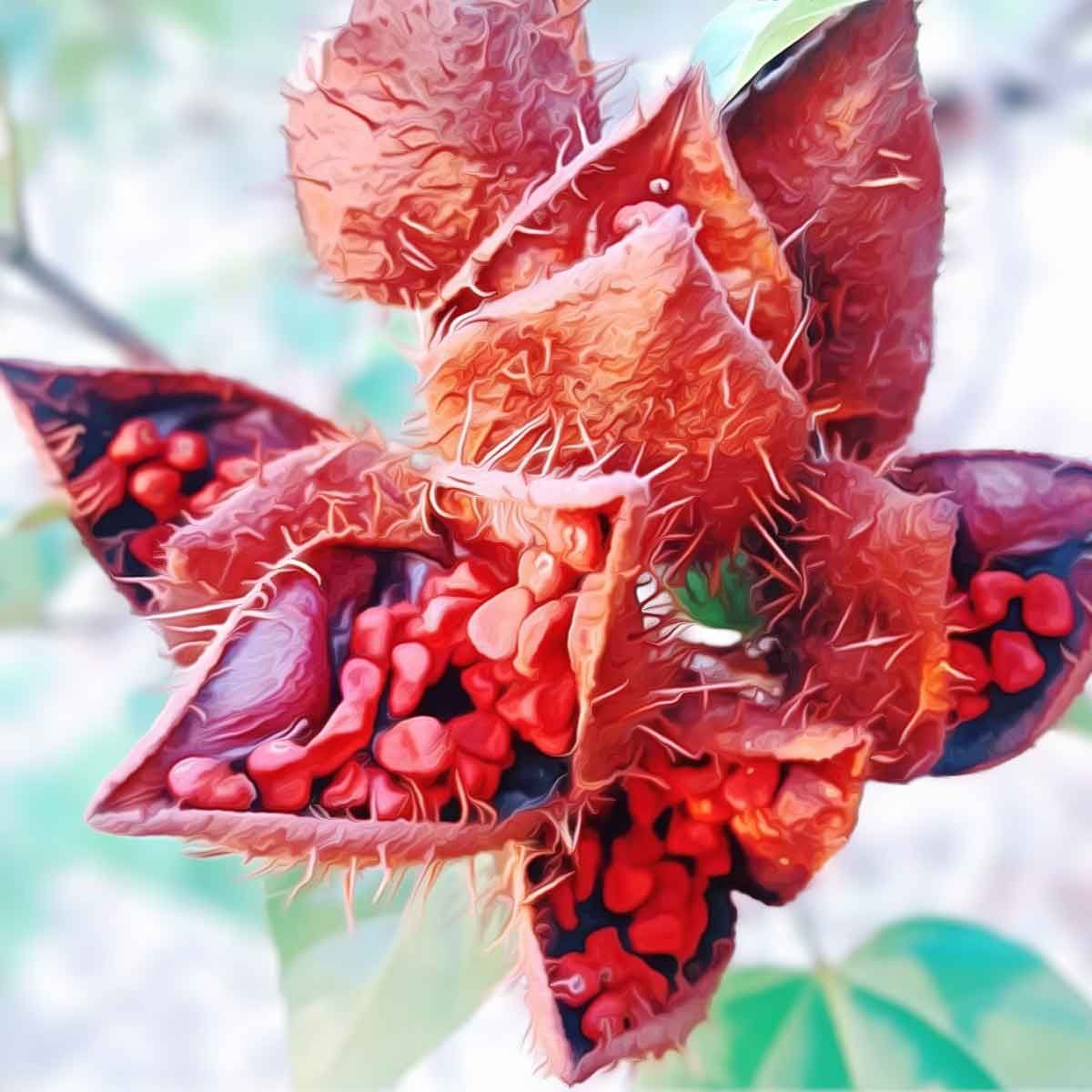More Coverage
Twitter Coverage
Satyaagrah
Written on
Satyaagrah
Written on
Satyaagrah
Written on
Satyaagrah
Written on
Satyaagrah
Written on
JOIN SATYAAGRAH SOCIAL MEDIA
"Symbols are powerful because they are the visible signs of invisible realities": Real Sindoor comes from a tree, a low-height tree that finds mention in our scriptures. Seeds from the tree are crushed to make fine powder and were used by Sita and Hanuman

Did you know | The real Sindoor comes from a tree? This Sidnoori tree (Bixa orellana) is a low-height tree and finds mentioned in our scriptures. Seeds from the tree are crushed to make fine powder which is the original sindoor believed to be used by Sitajee and also Hanumanjee when they were in the forest.
|
Saplings of this tree are available in government nurseries during the rains. Try and plant this tree this rainy season. Probably, u will be able to gift real sindoor to your friends/relatives. The synthetic sindoor in use is toxic. The natural sindoor is food-grade and has many healing uses in the Ayurvedic system.
The sindoor plant, also known as the lipstick tree or annatto, is a tropical evergreen tree that is native to South and Central America. It is grown for its vibrant red seeds, which are used as a dye in many cultures, as well as for its medicinal properties. Bixa Orellana/Sinduri grows well in full sunlight. It requires 3-6 hours of direct sunlight. Prefer a spot that receives morning sunlight as in hard summers the afternoon heat might burn the leaves.
Bixa orellana is a perennial, tall shrub that can reach 6–10 m (20–33 ft) high. It bears clusters of 5 cm (2 in) bright white or pink flowers, resembling single wild roses, that appear at the tips of the branches. The fruits of the Bixa orellana are globular, ovoid capsules arranged in clusters resembling spiky-looking red-brown seed pods covered in soft spines. Each capsule, or pod, contains 30–45 cone-shaped seeds covered in a thin waxy blood-red aril. When fully mature, the pod dries, hardens, and splits open, thereby exposing the seeds.
The shrub is most well known as the source of the red-orange annatto pigment. The pigment is derived from the pericarp (the waxy aril layer that covers the seeds) of the Bixa orellana fruit. The red-orange annatto dye is rich in carotenoid pigments, 80% which consists of bixin (the red pigment) and norbixin or orelline (the yellow pigment). Annatto oil contains tocotrienols, beta-carotene, essential oils, saturated and unsaturated fatty acids, flavonoids, and vitamin C.
|
Cultivation
Bixa orellana grows easily in subtropical to tropical climates, in frost-free regions sheltered from cool winds It prefers year-round moisture, good drainage, and moderately fertile soil in full sun or partial shade. It can be propagated from seed and cuttings. Cutting-grown plants flower at a younger age than seedlings.
The main commercial producers of B. orellana are countries in Latin America (specifically Peru, Brazil, and Mexico), which constitute 60% of total world production followed by Africa (27% of total world production) and Asia (12% of total world production). Production statistics are not usually available and would not provide a reliable guide to international trade, since many of the producing countries use significant quantities domestically (e.g., Brazil is a large producer and consumer, needing additional imports). Annual world production of dried annatto seed at the beginning of the 21st century was estimated at about 10,000 tons, of which 7,000 tons enter international trade. Peru is the largest exporter of annatto seed, annually about 4,000 tons; Brazil is the largest producer, with about 5,000 tons. Kenya exports annually about 1,500 tons annatto seed and extracts and is the second-largest exporter, after Peru. Côte d'Ivoire and Angola are also exporters
| How to Grow Sindoor Plant Easily at Home |
Growing a sindoor plant at home is relatively easy, as long as you provide it with the right growing conditions. Here are the steps to follow:
Choose the right location: The sindoor plant thrives in warm, humid climates, so it's best to keep it indoors in cooler regions. Place the plant in a spot that receives bright, indirect sunlight for at least 6 hours a day.
Planting: You can grow the sindoor plant from seeds or cuttings. If you choose to plant from seeds, soak them in water for a few hours before sowing them in well-draining soil. Cover the seeds with a thin layer of soil and keep the soil moist. If you are using cuttings, dip them in rooting hormone before planting them in a pot with well-draining soil.
Watering: Sindoor plant likes to be kept moist, but not waterlogged. Water the plant when the top layer of soil feels dry to the touch. Avoid overwatering, as this can lead to root rot.
Fertilizing: The sindoor plant is a heavy feeder and requires regular fertilization to grow well. Feed the plant with a balanced, water-soluble fertilizer every two weeks during the growing season.
Pruning: Sindoor plant can grow up to 20 feet tall, but can be pruned to maintain a more manageable size. Prune the plant in early spring before new growth appears. Remove any dead, damaged, or diseased branches, and trim back any branches that have grown too long.
Pests and Diseases: The sindoor plant is generally pest-free, but can be affected by mealybugs, scale insects, and spider mites. Check the plant regularly for signs of infestation, such as yellowing leaves or sticky residue on the leaves. Treat any infestations with insecticidal soap or neem oil. Sindoor plants can also be affected by root rot, which is caused by overwatering. To prevent this, make sure the soil is well-draining and avoid overwatering.
With the right care, your sindoor plant can grow into a beautiful and vibrant addition to your indoor garden. Enjoy the stunning red seeds and the many benefits they provide!
 Support Us
Support Us
Satyagraha was born from the heart of our land, with an undying aim to unveil the true essence of Bharat. It seeks to illuminate the hidden tales of our valiant freedom fighters and the rich chronicles that haven't yet sung their complete melody in the mainstream.
While platforms like NDTV and 'The Wire' effortlessly garner funds under the banner of safeguarding democracy, we at Satyagraha walk a different path. Our strength and resonance come from you. In this journey to weave a stronger Bharat, every little contribution amplifies our voice. Let's come together, contribute as you can, and champion the true spirit of our nation.
 |  |  |
| ICICI Bank of Satyaagrah | Razorpay Bank of Satyaagrah | PayPal Bank of Satyaagrah - For International Payments |
If all above doesn't work, then try the LINK below:
Please share the article on other platforms
DISCLAIMER: The author is solely responsible for the views expressed in this article. The author carries the responsibility for citing and/or licensing of images utilized within the text. The website also frequently uses non-commercial images for representational purposes only in line with the article. We are not responsible for the authenticity of such images. If some images have a copyright issue, we request the person/entity to contact us at This email address is being protected from spambots. You need JavaScript enabled to view it. and we will take the necessary actions to resolve the issue.
Related Articles
- "Varahamihira - ancient Astrologer, Astronomer and Mathematician": His encyclopaedic knowledge and lively presentation of subjects, as dry as astronomy, made him a celebrated figure, discovered trigonometric formulas and Pascal’s triangle
- "Sringara Prakasa - Sanskrit poetry": Classical theater, dancers (Bharatanatyam, Odissi, Mohiniyattam) refer to Sringara as 'the Mother of all rasas, one of the nine rasas, usually translated as erotic love, romantic love, or as attraction or beauty
- "Sanskrit is the language of philosophy, science, and religion": A Neuroscientist, James Hartzell explored the "Sanskrit Effect" and MRI scans proved that memorizing ancient mantras increases the size of brain regions associated with cognitive function
- "Culture is the widening of the mind and of the spirit": Origin of the timepiece AM and PM - Arohanam Martandasaya means the ascension (rise) of the sun, Patanam Martandasaya means the inclination of the sun
- Paramahansa Yogananda: Spiritual journey of a saint who was known as The Father of Yoga in the West
- "Function of ritual is to give form to human life, not in mere surface, but in depth": Kōlams - traditional Indian Patterns that combine Art, Mathematics & Magic, and refers to the belief that Hindus have a “karmic obligation” to “feed a thousand souls”
- "Aum Mahadevaya Namaha - The Great Universal God": Sanatana Dharma forces human mind, time and time again, to accept the fact that Divine is all that exists, both clean and unclean, pure and impure, auspicious and inauspicious
- "You don't have a soul. You are a Soul. You have a body": Anything lost, any work to be done, or any issue to be solved; first and foremost, people recall this divine 'Koragajja', one of the most sacred, worshipped, and sought-after spirits in Tulunadu
- "Three things cannot long be hidden: the sun, the moon, and the truth": It was not Isaac Newton but Rishi Kanad who first discovered "Laws of Motion" at least 2000 years before Newton in his Vaishesika Sutras, was also known as "Father of Atomic Theory"
- Legend of Maharishi Charaka also known as The father of Ayurveda: Earliest school of medicine known to mankind is Ayurveda
- Biggest Wonder of the World : Kitchen of Lord Shri Jagannath
- Dharm / Sanskriti
- Construction of Ram Mandir in Ayodhya is in full flow with the foundation work finished, main contractor for construction is Larsen & Toubro while Tata Consulting Engineers are project management consultant
- Gita Press Gorakhpur – Bringing Sacred Hindu Texts to Every Hindu Home
- “Birds teach a great life lesson. All you have to do is listen to their song”: Chilika in Odisha is the largest brackish water lake in Asia and great attraction for tourists for fishing, bird watching & boating, indigenous & migratory birds are a delight




























